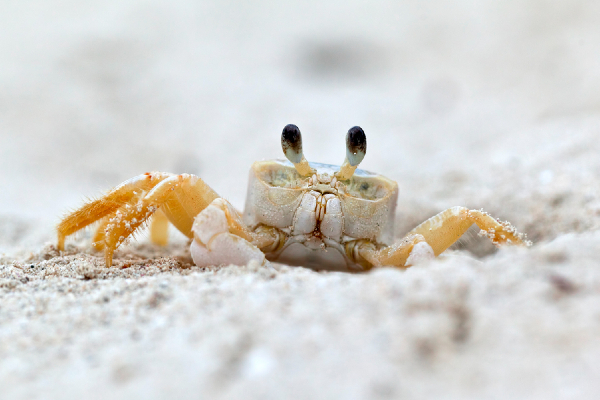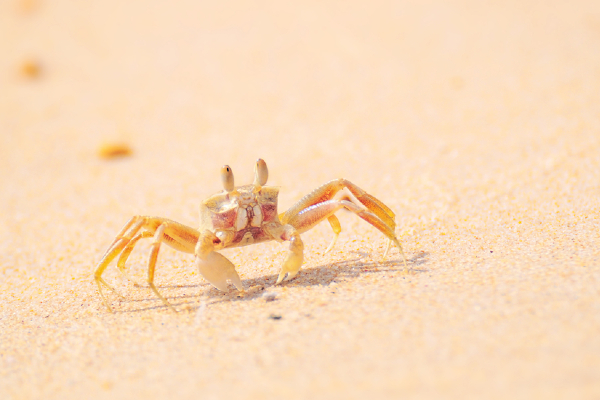The ghost crab is perhaps one of the most interesting and unusual creatures on the beach. These crabs are easily identified by their pale coloring and translucent shell, which makes them almost invisible against the sand. What makes these crabs really interesting, however, is their behavior. Ghost crabs are known for being very playful and active, and they are always exploring their surroundings. They are also quite fearless, and will approach people if they feel like it. If you’re lucky enough to see a ghost crab on the beach, make sure to take a close look at its unique personality!

Ghost Crab Description
Ghost crabs are a type of crab that is found on beaches around the world. They get their name from their ability to blend in with the sand, making them very hard to see. Ghost crabs are nocturnal creatures and spend most of their time in burrows that they dig in the sand. These burrows can be up to 3 feet deep and 6 feet wide. During the day, ghost crabs will close the entrance to their burrow with sand to stay cool and avoid predators. Ghost crabs are opportunistic eaters and will eat just about anything they can find, including insects, small animals, and even other crabs. Ghost crabs are also known for their ability to run very fast. Ghost crabs are interesting creatures that are fun to watch and learn about.
Ghost Crab Habitat
Ghost crabs are a type of crab that lives in the sand on beaches. They get their name from their ability to blend in with the sand and from their nocturnal habits. Ghost crabs are not very social and live alone in burrows that they dig themselves. The Ghost Crab’s diet consists mostly of small invertebrates that live on the beach, such as bugs and worms. Ghost crabs also like to eat vegetables and sometimes other crabs. Ghost crabs are important to the ecosystem because they help to keep the beach clean by eating dead animals and plants. Ghost crabs are also an important food source for other animals, such as birds. Ghost crabs are threatened by habitat loss due to coastal development, pollution, and climate change.
Ghost Crab Diet
Ghost crabs are opportunistic feeders and will consume a variety of food items. The diet of ghost crabs is primarily determined by what is available in their local environment. Ghost crabs have been known to eat small mammals, reptiles, birds, carrion, and even other Ghost crabs. Ghost crabs will also scavenge for food items such as seaweed, clams, and dead fish. In addition to their scavenging activities, Ghost crabs are also able to capture live prey. Live prey items that have been identified in the diet of Ghost crabs include small insects, snails, and crabs. Overall, the Ghost crab diet is quite variable and dependent on what is available in their local environment.
Ghost Crab Size
Ghost crabs are small crabs that range in size from about 2 to 3 inches long. They are named for their pale, translucent shell, which makes them look like ghosts. Ghost crabs are found on beaches around the world, where they burrow into the sand to make their home. They are scavengers and will eat just about anything they can find, including dead fish, seaweed, and even other ghost crabs. Ghost crabs are also known for their agility and speed. They can run up to 9 miles per hour, making them one of the fastest animals on the beach. When they feel threatened, they will sometimes play dead to avoid being eaten by predators. Ghost crabs are fascinating creatures that play an important role on the beach ecosystem.

Ghost Crab Lifespan
Ghost crabs are one of the most interesting creatures on the beach. These nocturnal animals are well known for their unique appearance, as well as their fleet feet. Ghost crabs are also relatively short-lived creatures, with most individuals only living for 2-3 years. Despite their relatively short lifespan, ghost crabs play an important role in the ecosystem of the beach. Ghost crabs are opportunistic eaters, and their diet helps to keep the population of other animals in check. In addition, ghost crabs help to Aerate the sand and keep the beach clean. As a result, Ghost crabs play an important role in the health of the beach ecosystem despite their short lifespan.
Ghost Crab Behavior
Ghost Crabs are unique creatures, known for their nocturnal habits and their ability to burrow quickly into the sand. These crustaceans are also highly adaptable, able to live in a variety of habitats ranging from the intertidal zone to the open ocean. Ghost Crabs are opportunistic feeders, and will scavenge for food as well as hunt live prey. They are also known to be aggressive, and will defend their territory from other Ghost Crabs. Ghost Crab behavior is therefore complex and fascinating, making them a popular subject of study for scientists.
Ghost Crab Speed
Ghost crabs are among the fastest animals on the planet, reaching speeds of up to 25 miles per hour. They are able to achieve these high speeds thanks to their long legs and large claws, which they use to propel themselves forward. Ghost crabs are also incredibly agile, able to change direction quickly and easily. This makes them difficult to catch, even for the swiftest predators. Ghost crabs are native to tropical and subtropical regions, where they live on beaches and in sand dunes. They are nocturnal creatures, spending the day buried in the sand and emerging at night to hunt for food. Ghost crabs are omnivorous, eating everything from other crustaceans to plants and small mammals. These fascinating creatures are a joy to watch, whether they’re scurrying along the beach or playing hide-and-seek in the sand dunes.
Ghost Crab Hunting
Ghost crabs are a type of crab that is found in tropical and subtropical climates. They get their name from their ability to change their color to match their surroundings, making them difficult to spot. Ghost crabs are excellent scavengers and can often be found near the shoreline, searching for food. Ghost crab hunting is a popular activity in many coastal areas, as they are considered to be a delicacy. The best time to hunt for ghost crabs is at night, when they are most active. Ghost crabs can be caught using baited traps or by netting them as they scurry along the beach. Once caught, they can be cooked and eaten whole. Ghost crab hunting is a fun and challenging way to enjoy the outdoors and learn about these fascinating creatures.
Conclusion
Ghost crabs are interesting creatures that can be found on many beaches. They are easy to identify by their bright white shells and the way they quickly run away from people. These crabs have some unique adaptations that help them survive in their environment, such as their ability to change color and the sand-trapping hairs on their claws. If you’re lucky enough to see a ghost crab on the beach, make sure to take a picture!
Frequently Asked Question

